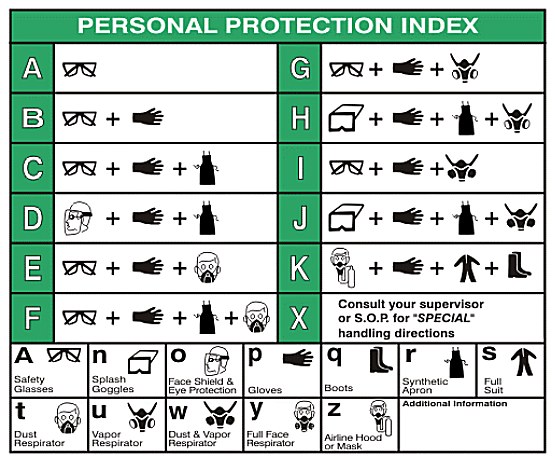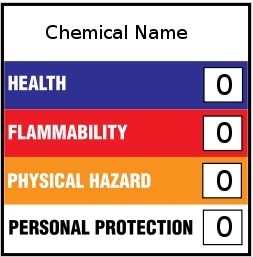HMIS Color Bar Information
Blue/Health
The Health section conveys the health hazards of the material. In the latest version of HMIS, the Health bar has two spaces, one for an asterisk and one for a numeric hazard rating. If present, the asterisk signifies a chronic health hazard, meaning that long-term exposure to the material could cause a health problem such as emphysema or kidney damage. According to NPCA, the numeric hazard assessment procedure differs from that used by NFPA.
- 4. Life-threatening, major or permanent damage may result from single or repeated overexposures (e.g., hydrogen cyanide).
- 3. Major injury likely unless prompt action is taken and medical treatment is given.
- 2. Temporary or minor injury may occur.
- 1. Irritation or minor reversible injury possible.
- 0. No significant risk to health.
Red/Flammability
For HMIS I and II, the criteria used to assign numeric values (0 = low hazard to 4 = high hazard) are identical to those used by NFPA. In other words, in this category, the systems are identical. For HMIS III, the flammability criteria are defined according to OSHA standards.
- 4. Flammable gases, or very volatile flammable liquids with flash points below 73 °F (23 °C), and boiling points below 100 °F (38 °C). Materials may ignite spontaneously with air (e.g., Propane).
- 3. Materials capable of ignition under almost all normal temperature conditions. Includes flammable liquids with flash points below 73 °F (23 °C) and boiling points above 100 °F (38 °C), as well as liquids with flash points between 73 °F and 100 °F.
- 2. Materials which must be moderately heated or exposed to high ambient temperatures before ignition will occur. Includes liquids having a flash point at or above 100 °F (38 °C) but below 200 °F (93 °C) (e.g., Diesel fuel).
- 1. Materials that must be preheated before ignition will occur. Includes liquids, solids and semi solids having a flash point above 200 °F (93 °C) (e.g., Canola oil).
- 0. Materials that will not burn (e.g., Water).
Orange/Physical Hazard
Reactivity hazard are assessed using the OSHA criterion of physical hazard. Seven such hazard classes are recognized: Water Reactives, Organic Peroxides, Explosives, Compressed gases, Pyrophoric materials, Oxidizers, and Unstable Reactives.
- 4. Materials that are readily capable of explosive water reaction, detonation or explosive decomposition, polymerization, or self-reaction at normal temperature and pressure.
- 3. Materials that may form explosive mixtures with water and are capable of detonation or explosive reaction in the presence of a strong initiating source. Materials may polymerize, decompose, self-react, or undergo other chemical change at normal temperature and pressure with moderate risk of explosion.
- 2. Materials that are unstable and may undergo violent chemical changes at normal temperature and pressure with low risk for explosion. Materials may react violently with water or form peroxides upon exposure to air.
- 1. Materials that are normally stable but can become unstable (self-react) at high temperatures and pressures. Materials may react non-violently with water or undergo hazardous polymerization in the absence of inhibitors.
- 0. Materials that are normally stable, even under fire conditions, and will not react with water, polymerize, decompose, condense, or self-react. Non-explosives.
White/Personal Protection
This is by far the largest area of difference between the NFPA and HMIS systems. In the NFPA system, the white area is used to convey special hazards whereas HMIS uses the white section to indicate what personal protective equipment (PPE) should be used when working with the material. Below is a guide for this area.


